"For in the final analysis, our most basic common link is that we all inhabit this small planet. We all breathe the same air. We all cherish our children's futures. And we are all mortal." -John F. Kennedy
After a great week over on the new Starts With A Bang blog, where we covered a whole slew of topics like:
- Long Term Timekeeping (for Ask Ethan #30),
- The Amazing Lives of Coral Reefs (for our Weekend Diversion),
- The Biggest one of them All, M87 (for Messier Monday),
- Why are there (at most) eight planets in our Solar System?,
- The Multiverse is not the answer, and the great long-read,
- Global Warming for Beginners (for Throwback Thursday),
and you weighed in here with your comments, with some really excellent discussions arising, particularly on the Multiverse post. Let's dive right in, and take a look at your Comments of the Week!
From Truthspew on the topic of Long Term Timekeeping: I would think if they brought an atomic clock on board with them the time would still be earth based but what we’re used to doing.
You see, it's be fantastic if we could keep time for arbitrary lengths using atomic clocks. Indeed, they're far more accurate than any natural clocks, including millisecond pulsars or radioactive decay times. But although that's a brilliant idea in principle, there's a wrench in the works when it comes to practicality.
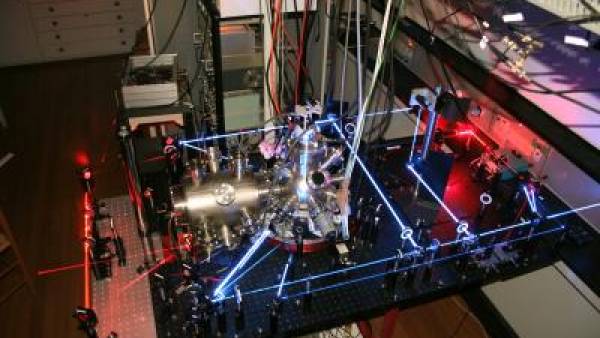 Image credit: Niels Bohr Institute, via http://www.sciencenewsline.com/summary/2011090718160031.html.
Image credit: Niels Bohr Institute, via http://www.sciencenewsline.com/summary/2011090718160031.html.
Atomic clocks require a lot of power to continuously stimulate atomic transitions, and a lot of cryogenic fuel to keep the atoms at ultra-low temperatures. Not such a big deal when you're talking about doing this in a continuously powered laboratory on Earth, but that's a lot of resources to devote to keeping a simple clock running. The mechanism I gave in the original article -- counting atoms or looking at a pulsar -- has the advantage that all you have to do is look once at the beginning and once at the end, and requires no devoted power in the intermediate time. If you can figure out a way to do that with atomic clocks, I'll happily revise my answer! (Also, you'll probably win a Nobel Prize along the way, an arguably greater accolade.)
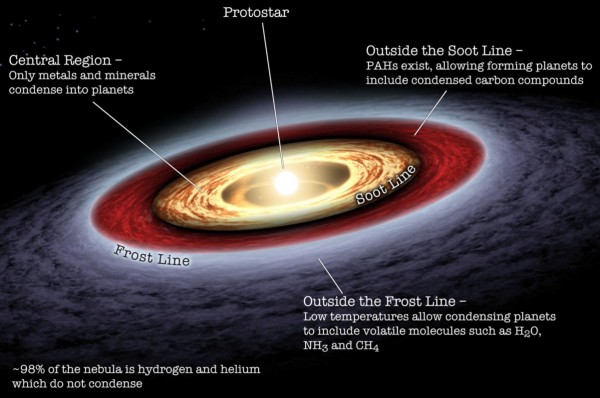 Image credit: NASA / JPL-Caltech, InvaderXan of http://supernovacondensate.net/.
Image credit: NASA / JPL-Caltech, InvaderXan of http://supernovacondensate.net/.
From Colin Burgess on the subject of the number of planets in the Solar System: Why did the asteroid belt form at the frost line, rather than another frozen planet/s? Is there something special about the asteroids straddling this line, that caused an inability for planet formation?
It seems like that would be the dichotomy, doesn't it? Why do we have a belt of asteroids instead of a planet there? As it turns out, having a planet at the Solar System's frost line is probably an extremely rare occurrence, while having asteroids at that location ought to happen in the majority of Solar Systems. The key comes down to what the "frost line" actually means.
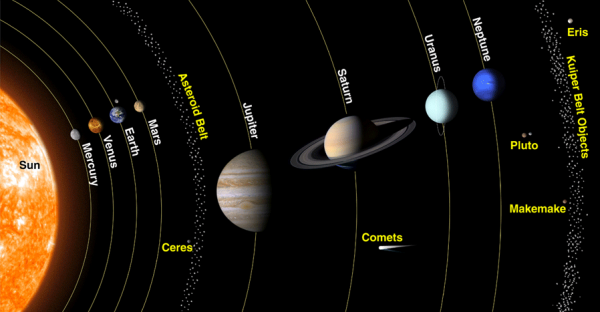 Image credit: NASA’s The Space Place, via http://spaceplace.nasa.gov/ice-dwarf/.
Image credit: NASA’s The Space Place, via http://spaceplace.nasa.gov/ice-dwarf/.
Inside of the frost line, solid hydrogen-based compounds like water, ammonia and methane cannot exist; the temperature and energy flux from the parent star is too high. Planets land where they land during Solar System formation, but so long as no giant planets have migrated from outside the frost line to inside (disrupting the belt), there will be leftover material at the frost line and beyond. And unless you happen to live in the rare star system that happened to form a planet right at the frost line, you'll expect there to be an asteroid belt until you near the vicinity of the first giant planet outside the frost line.
We normally think of our asteroid belt as a "belt", but in reality, its component asteroids span from about 2 AU to 3.3 AU, with a total of just 4% the mass of our Moon. There simply isn't enough material there to make a planet, and this is the case in the vast majority of Solar Systems.
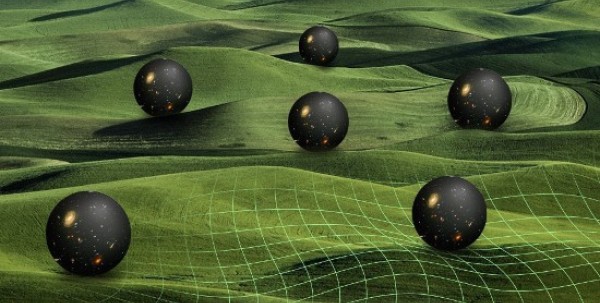 Image credit: Mario Livio, via http://www.huffingtonpost.com/mario-livio/how-can-we-tell-if-a-multiver….
Image credit: Mario Livio, via http://www.huffingtonpost.com/mario-livio/how-can-we-tell-if-a-multiver….
From David L as respects The Multiverse is not the answer: Is there any reason to suspect [other Universes] would be “like” our own? Would what we consider universal constants have to be the same there?
You must remember that our Universe is all we have access to. What the CMB spectrum of fluctuations and the BICEP2 results tell us about inflation is that it occurred at an energy of ~a few × 10^16 GeV, which is well below both the Planck energy and the (hypothesized) string scale. We know -- from observations of our own Universe -- that having the Universe up at this scale and then allowing it to have inflation end and a Hot Big Bang ensue cannot result in different fundamental constants. The possibility of universal (sic) constants having different values relies on the dual assumption that there are inflationary regions that had much greater energies than where our Universe was just prior to the end of inflation and also that those energies would allow the possibility of falling into a different low-energy state than our own. Yes, it's possible, but there's no compelling reason -- either theoretical or experimental -- to suspect that this is true.
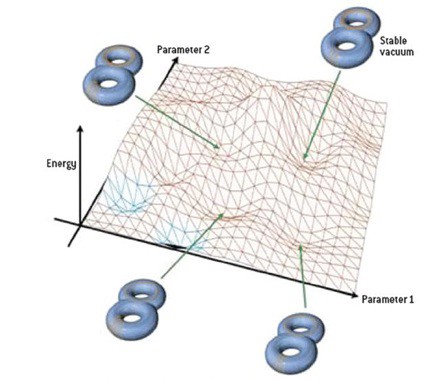 Image credit: University of Cambridge, via http://www.ctc.cam.ac.uk/research/fundamental_theory_and_cosmology.php.
Image credit: University of Cambridge, via http://www.ctc.cam.ac.uk/research/fundamental_theory_and_cosmology.php.
From Tom Campbell-Ricketts on The Multiverse is not the answer: I have tried to investigate what types of anthropic reasoning are valid, but I confess, the problem is difficult, and I’ve not found a satisfactory answer.
You know, I have no problem when anthropic reasoning is used as sort of a self-evidence sanity check for the Universe. As I've said before:
The laws of nature must be such that the Universe can exist in a fashion consistent with what it is observed to be.
The presence of carbon in the Universe tells us there must've been a mechanism for carbon to be created. The existence of galaxies and planets tells us that the cosmological constant must've been small enough to allow for the formation of galaxies and planets. But anthropic reasoning is only interesting in a scientific sense if it can point us towards a direction that helps us understand how the Universe came to be the way it is. Without that caveat -- without a testable prediction to explore -- there may still be other philosophical or mathematical reasons to take an interest in what anthropics can tell you, but it's not scientifically interesting.
From veyd on Global Warming for Beginners: [W]hile i’ve long accepted that rising climate temperature is an ongoing and scientific fact, it’s also been a long time since i had any interest of reading any more about it. [I]’m not an activist and there is not very much we can do as individuals about this. [S]o i was going to skip this one too, but the explanation involving the planets was such an interesting twist, [I] just had to read on.
One of my favorite things about science is that it's such a rich store of human knowledge that if you ask 100 experts in a field to tell you the story of some aspect of their field, you will get 100 different versions of the same story, and -- so long as they stick to the known, conclusive science and don't resort to their own pet speculations -- they'll all be consistent with one another. I've never claimed to be the expert on anything and I don't fancy myself to be one, but I'm fortunate to be enough of an expert on some facets of science that I can tell you the story as it makes sense to me. I can show you the threads that come together to form the tapestry, and, if I'm doing it right, you can see the same picture I do at the end of it. I'm happy to have you along for the journey, and many of you are providing me with valuable perspectives on how you make sense of things.
Cheers, and thanks for another great week!

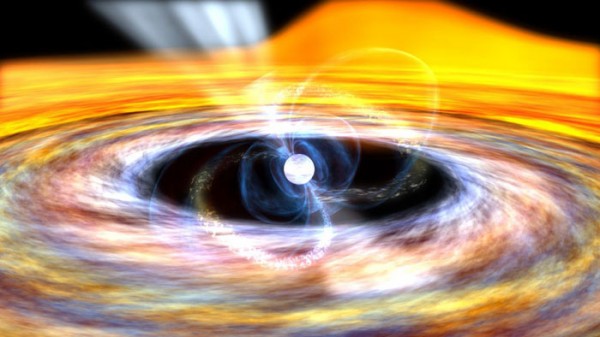

Cold-atom clocks rely on laser cooling, not cryogenics, to get the atoms cold.
Tom -- the atoms have to be very cold, at cryogenic temperatures, before the laser-cooling technique can be applied.
Aha!, I see where I made an error in my comments in the previous "Multiverse" blog, so here goes for an attempt to correct that (or make another error):
I was assuming that observations of this universe could point to physical laws in the multiverse, and that the uniformity of those physical laws would result in other universes being essentially similar to our own.
But what I missed was the possibility that the energy density of the multiverse could be other than uniform, such as to result in the emergence of universes with different starting energy densities, leading to different values for key variables, leading to substantially different physics compared to what we observe in our universe.
Ethan considers that scenario improbable, which is sufficient for me to agree unless someone has a better counter-arguement. The result is that it's more likely that other universes resemble our own, but the possibility of wider divergence can't be ruled out at at this point.
Is that anywhere near correct?
Reading the last batch of comments in the previous "multiverse" blog, I think there's a lack of clarity in the use of certain words, so I'll offer the following as an attempt:
1) Function: The role of an entity in the context of a system governed by conventional forward causality, e.g. "carbon has certain functions in biological systems."
2) Purpose: The role of an entity in teleological causality, e.g. "the purpose of carbon is to provide a foundation for biological systems." Statements of purpose are generally untestable and fall into the realm of philosophy and value judgements, rather than the realm of science. Discussions of purpose aren't useful in these blogs, and should be saved for philosophical forums.
3) Meaning, logical/mathematical: Usefulness in the context of a testable hypothesis. A statement such as "gravity distorts spacetime" is scientifically meaningful in that it can be expressed in more specific mathematical terms and used to build testable hypotheses, such as for observing the effect of stars on light from objects behind them.
4) Meaning, subjective/personal: The subjective sense that a relationship exists between two or more objects or events, whether one or more of them are concrete, and one or more are symbolic (for example a statue representing a historic event that occurred in a given location). Something that is "subjectively meaningful" or "personally meaningful" may or may not lead to one or more statements that are logically or mathematically meaningful.
--
Other: Sinisa, re. your comment in the "multiverse" blog about multiverse theories vs. many-worlds interpretations of QM: YES, and I made that mistake early & often until recently. That's another case that's similar to "function vs. purpose" or "logical meaning vs. personal meaning," where the language is similar and there's a risk of confusing two different things.
I am not sure what Ethan means by this sentence
"BICEP2 results tell us about inflation is that it occurred at an energy of ~a few × 10^16 GeV, which is well below both the Planck energy..."
Plank scale is at 10^19 GeV, which is damn close IMO. It's not 20 orders of magnitute different, or 120...
Yes, it's not at exactly plank scales, but very near them. It's like comparing millimeter and meter.. 3 orders difference.
Hi Ethan
Thanks for re-posting and addressing my comment.
Sanity checks are good, but the main point of anthropic reasoning is not some cheap procedure to check our algebra. There are proposed arguments that would actually provide additional evidence about the state of reality. Some of these arguments are quite appealing. If we are to say that these arguments are no good, we should have robust theoretical reasons for doing so.
You say:
"there may still be other philosophical or mathematical reasons to take an interest in what anthropics can tell you, but it’s not scientifically interesting"
I believe this is mistaken.
By admitting it might be mathematically or philosophically interesting, you seem to support that it might represent valid reasoning. In which case, it can not be scientifically irrelevant.
For example, we are justified in wondering why the universe seems to be remarkably finely tuned for us to exist in it. If it is the only universe, our existence seems less probable than if there are vast numbers of 'universes': P(us | multiverse) > P(us | single bite at the apple). From Bayes' theorem, the posterior, P(multiverse) receives a boost - the multiverse theory helps explain our existence. If the inequality with which I related these likelihoods is valid, then this is valid scientific reasoning.
Tom
tom, your repeated references to bayes theorem leave me less than impressed, especially after you completely misinterpret the meaning of something as simple as a confidence interval on your blog.
Hi dean,
Would you care to explain? How have I misrepresented the meaning of confidence intervals?
Is there anything about my use of Bayes' theorem that you can find fault with?
Michael-
No, the atoms involved are typically room temperature-ish at the start. I do this for a living. Cryogenics are not involved with getting the atoms cold in cold-atom clocks.
@Tom #9: I'm a bit confused (and I'm a different Michael than #2, to whom you were replying). My understanding (I'm HEP, not AMO, so you're the expert here) is that you put a sample of atoms into a trap, and then use laser cooling to get them down to uK-ish temperatures.
But to get them into the trap and have them stay there, the atoms _do_ need to be cooled via standard refrigeration techniques, down to lN2 levels.
I would have thought that the typical thermal speeds at room temperature, a few hundred m/s, would be too fast for Doppler cooling to do any good before the dilute gas expanded away.
The lasers are the trap — they provide the slowing and cooling. What you want to Google is "magneto-optical trap" (and/or "optical molasses", which is a closely related effect). Near-resonant laser accelerations can be really big. Even a thermal sample has atoms moving slow enough that they can be trapped.
In many AMO experiments the atoms are then transferred to other, shallower traps where further cooling can occur.
@Tom #11: Thanks! Wikipedia is my friend.
Your comment above, "Even a thermal sample as atoms moving slow[ly] enough..." makes it sound like only the far tail of the Maxwellian gets captured. What I found sounds like things can be more efficient than that (and still fully consistent with your original statement in #9, which I now understand).
It seems that MOTs are generally loaded with atoms travelling at a few m/s (i.e., kelvin-ish temperature or "cryogenic"), but those are obtained themselves through a laser cooling technique labelled a "Zeeman slower" -- which uses a single detuned laser in the antibeam direction to slow atoms from room temperature down to where they can be captured in the MOT or optical molasses.
In any event, it's always good to learn something new. Thanks again!
You can use a Zeeman slower (or what is called "chirped" cooling), but it's also common to simply capture from a vapor, especially for alkalis, which have a decent vapor pressure at room temperature. At ~10^-8 torr of vapor you can get a pretty beefy trap.
@Tom #13: Thanks again; it is always great to get the details from a practitioner. Do you read Chad Orzel's blog on this site? He's also an AMO guy, and often blogs about recent developments.
Haven't seen this many inaccuracies and hand waving in one place in a long time.
@hiphor #15: You must not read the anti-science blogs, or watch Fox News, then. It's great that your sources of information are limited to peer-reviewed journal articles.
@Michael Kelsey
Why the ranting, do you think naming a site "scienceblogs" immunizes it from scrutiny? Filling out "SLAC" as your location seems to have pumped you up with superpowers to the point of delusion.
hiphor,
You are new here, so I will direct you to our comments policy, which should point out to you how to conduct yourself if you want to keep commenting privileges on this site.
How you choose to continue is up to you, but I am cautioning you against abusing other people -- because I see it coming -- under my watch.
I was wondering if instead of trying to find life on other planets, we could create our own planet, using a large nuclear powered electromagnetic,we could launch it into space and have it set in a orbit that's just the right distance from the sun, near a large asteroid field, when it is turned on it would pull in metal asteroid fragments in, and begin to grow in size, as it grows in size, it would all so start to have a gravitational pull, to pull in asteroids that are not metallic, the Earths core is liquid Iron, a nuclear reactor melt down inside the new planet, could create this liquid metal core, after it no longer needs the giant electromagnetic to help it grow.